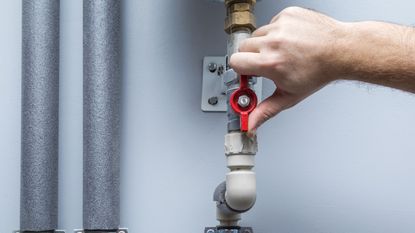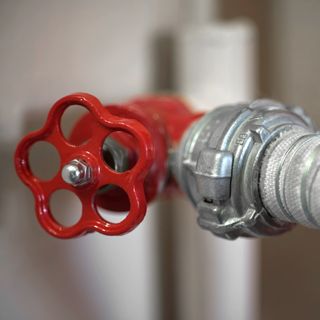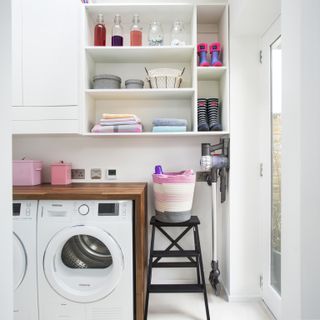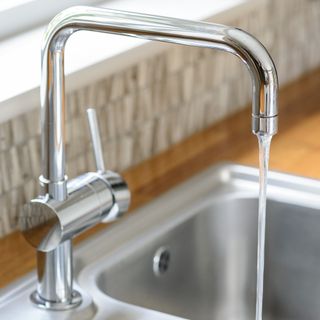Where is my stopcock? How to easily locate your stop tap
All the places your stopcock might be hiding and what to do to if not


If you're on the hunt for your home's stopcock and not having much luck, don't worry we can help you locate it in no time, so you can quickly solve any water-related issues you're facing.
Even if your home's water is all good right now, it's handy to know where your stopcock is. You'll be thanking yourself for taking the trouble to find it now if you're unfortunate enough to experience a leak or need to fix a dripping tap in the future.
'A stopcock controls your mains water supply – and therefore it’s your first port of call should there be a broken tap, leak or burst pipe', explains Darren Whelpton-Smith, Trading Manager at Plumbing Superstore.
'When this happens, knowing where the stop tap is can save you a lot of damage and pennies', says Rebecca, co-owner of Lacey Plumbing and Heating. 'The sooner you can close it off the less likely you are going to encounter flooding or superficial repairs.'
Whether you need to learn how to unblock a toilet, how to fix a shower head or you just want to know for future reference, we've got six simple steps to help you locate your home's stopcock if ever you need to turn your home's water off.
What is a stopcock?

Before you start trying to locate your stopcock, it's helpful to know what you're looking for. A stopcock is a tap that can shut off your home's water supply, but it isn't identical to the regular taps on your sink.
'The stopcock looks like the top of an outdoor tap, but without a spout to let water out', explains Rebecca from Lacey Plumbing and Heating. 'The stopcock will sit between two pipes, working as a connector, so it can block the water flow when it’s closed.’
'Your home's stopcock rests on top of an existing section of pipe and resembles a tap without a spout', agrees Richard Southern, plumbing expert at PriceYourJob. 'Twisting it stops the flow of water and controls how two different parts are connected.'
Where is my stopcock? How to locate it
1. Check under your kitchen sink
Under the kitchen sink is the most common location the stopcock will be in, as this is often where the cold water feed enters the house. If the stopcock is under your kitchen sink, you'll see a pipe running down the back wall with a T-bar attached to it. If you can see this when you open your sink door, then you're in luck and can stop searching there.

2. If you have a downstairs toilet or utility room, try there
If you had no luck under the kitchen sink, the next places to check are your downstairs toilet or utility room if you have them. The stopcock may be hiding behind your washing machine, or under the sink next to the downstairs loo.

3. Check near your gas or electric meter
Some stopcocks are positioned next to your gas and electric meter, though this is less likely in new builds. Depending on where your meter is located, your house's cold water pipe may be near, so definitely check here. Underneath the stairs, in the hallway or in the garage are good places to check for the stopcock anyway, even if your meter is located elsewhere.
4. Study your house plans
If you've looked in the locations we suggested above and the stopcock is still evading you, it might be time to look at the plans to your house if you can. Search for an 'SC' marking to find out where the stopcock is.
If the kitchen has been renovated, it may still be in its original location away from the new sink, or it could be in a bathroom. You should be able to access the house plans through your local council.
5. Ask your neighbours
'If you’re still struggling to find your stopcock and you live in a house similar to a neighbour, such as on a newbuild development or in a period property, it’s always worth asking them if they know where their stop tap is', says plumbing expert Rebecca.
If your's and your neighbour's properties were built at the same time, your stopcocks will be located in the exact same place.
6. Contact your water supplier
Failing all the above steps, you can get in touch with your local water authority and ask them where your stopcock is.
'Ask your water supplier where the external stop tap is located and where your water's entry point to your house is', advises Lydia Luxford, Technical Services Manager at Easy Bathrooms.
‘Your internal stopcock is likely to be in line with the external stop tap on the inside of your property.'

What to do if you can't find your stopcock
If you can't find your internal stopcock, don't give up, as it will definitely be hiding somewhere. Make sure you've thoroughly checked under the kitchen sink, beneath the stairs, in the hallway, garage, utility room and downstairs bathroom. These are the most common locations for your internal stop tap and you should be able to find it in one of these.
It could be that the house has undergone a renovation. The stopcock is rarely moved when your house undergoes renovations, which may explain why it doesn't seem to be in the places you're looking. That is why it's always worth taking a look over the plans to your house when searching for it.
If you have an external stop tap and know where this is, your internal one will be in line with this on the inside of the wall, as they both follow the main water line for your property.
But if you're still having trouble finding it, don't be afraid to ask your neighbours. If you live in a new development or a similar house, they will more than likely be in the same place. Hopefully they've already managed to locate theirs and it will save you looking further!
Still no luck? Contact your local water authority and they should be able to help you find your stop tap if you give them the relevant info.
Where is my external stopcock?
While every house has an inside stopcock, it isn't guaranteed that you'll have an outside stopcock as well.
'Not every home has an outside stopcock, which is especially true for older properties', says plumbing expert Richard. 'Likewise if your water supply is shared with one or more of your neighbours, you won't necessarily have your own external stopcock.'
If you do have an external stopcock, it will be located outside along the edge of your property, and your water provider is responsible for fixing it if there is a leak. If you have a water meter, it will likely be located in the same pit as the meter.
You may need permission to operate the external stop tap, even in the event of an emergency, so always check with your local council or water authority before you use it.
Get the Ideal Home Newsletter
Sign up to our newsletter for style and decor inspiration, house makeovers, project advice and more.

Katie Sims has been writing for Ideal Homes since spring 2022. She qualified from her Master’s in Media and Journalism in 2021 and has been writing freelance since. She has worked on Ideal Home’s ecommerce team where she researched the best home products on the market, and on the news team, researching the latest trends for feature pieces.
-
 Cats pooping in your garden? The ‘scaredy cat’ plant could be the answer to all of your problems
Cats pooping in your garden? The ‘scaredy cat’ plant could be the answer to all of your problemsKeep cats out of your garden for less than £1.50 per plant
By Lauren Bradbury
-
 How to clean a hot tub filter to keep it in great working order with this expert advice
How to clean a hot tub filter to keep it in great working order with this expert adviceFeature Wondering how to clean a hot tub filter? Get sparkling, clear water in your hot tub with this expert advice
By Olivia Bevan
-
 This is when to prune your weigela plant so it bears even more flowers next year
This is when to prune your weigela plant so it bears even more flowers next yearExpert highlight the best time to prune weigela to avoid poor flowering
By Sara Hesikova